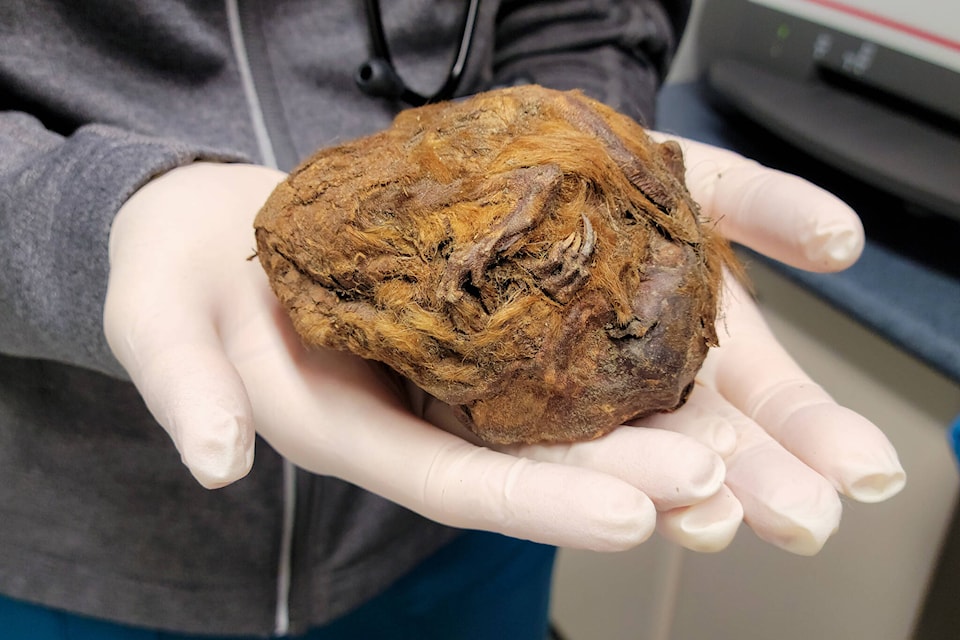When Diana Phillips, a local Yukon miner who mined the Hester Creek in the Klondike gold fields near Dawson City, found an Arctic ground squirrel in 2018, she wasn’t quite sure what it was.
Phillips called the Yukon Beringia Interpretive Centre, a research and exhibition facility, and sent photos of what she had found. Researchers and scientists at the centre confirmed it to be the specimen of a 30,000 year-old Arctic ground squirrel which existed in the Yukon during the ice age.
With the help of the Alpine Veterinary Medical Centre in Whitehorse, the Beringia Centre was able to get x-rays of the remains of the Arctic ground squirrel.
“It’s pretty interesting because it was mummified and came in a round shape of a ball with skin and hair, tiny hands and tail,” said Yukon paleontologist Grant Zazula. “If you just look at the photo of what it is, it looks like a frozen ball of skin and hair but at the x-ray, you see the skeleton of a little Arctic ground squirrel curled up in a fetal and sweeping position that showed that it must have died while it was hibernating.”
Zazula said Phillips and her family are aware of his fascination for squirrels and are quite interested and supportive of their research and work at the centre, including collecting ice age fossils, and bones and teeth.
He added that one of the things they receive quite regularly from miners in the Klondike gold fields is frozen nests of Arctic ground squirrels.
Arctic ground squirrels, which are well adapted to the Arctic world, existed during the ice age.
Zazula, who has studied squirrels for many years with particular interest in Arctic ground squirrels, said the Arctic ground squirrel survives long winters by hibernating for seven or eight months of the year.
“So, this was clearly an Arctic ground squirrel that froze to death during the end of the ice age some 30,000 years ago,” he said. “We feel it’s a pretty cool specimen to have on exhibition.”
Officials at the Beringia Centre said the oldest discovered Arctic ground squirrel remains have been found in Alaska and date back 1.8 to 2.5 million years.
Zazula said the centre is working on an exhibition where the discovered Arctic ground squirrel will be displayed among other specimens in their collections for visitors.
The paleontologist told the News that the Beringia Centre is not looking at doing any kind of research on the discovered squirrel because there is a lot of published research on Arctic ground squirrels of the ice age.
“For me, this is a really important specimen to get on display because there is going to be a whole lot of new exhibitions going on in the Beringia Centre and one of them will feature Arctic ground squirrels,” he said.
During the planned exhibition, Zazula said visitors will get a chance to see preserved Arctic ground squirrel nests and the different types of plants that are found in them. Visitors will also have a chance to see mummified Arctic ground squirrels.
The Beringia Centre has a growing list of mummified animals from the ice age which were discovered by miners in the territory.
A mummified caribou calf was found on Tony Beets’ placer gold mine on Paradise Hill on June 3, 2016.
The ice age caribou was discovered at a site that contains a volcanic ash bed that dates to approximately 80,000 years ago, making this among the oldest mummified mammal tissue in the world. It represents nearly the entire front half of the caribou carcass, including torso, head, two front legs with skin, muscle and hair intact.
In the same year, a mummified wolf pup was discovered in July on the Favron Enterprises Ltd. claim. The specimen is preserved at the Beringia Centre with head, tail, paws, skin and hair.
The specimens of the caribou and wolf pup date to over 50,000 years old.
The Canadian Conservation Institute accepted both specimens for conservation because of their scientific significance.
“I think it will be fascinating to have a mummified animal on display,” Zazulu said. “We study bones and skeletons and checks and things like that but with mummified animals, you really get a chance to see an inch of the animal up close and complete with skin and hair; you can really get an amazing window to think about how the animals lived while they were in existence.”
He added that a mummified animals on display will give visitors a sense of how animals lived in the past in the Yukon, how they survived or went extinct and how those changes occurred.
Zazula noted that Arctic ground squirrels are a special kind of animals. Unlike any of the ice age animals, he said, Arctic ground squirrels survived.
“They didn’t go extinct and were able to survive those climate changes that were occurring in the Yukon at the end of the ice age and they found new ways to live,” he said. “It’s interesting to think about and consider the animals that survived the end of the ice age rather than the ones that did go extinct.”
Contact Patrick Egwu at patrick.egwu@yukon-news.com
